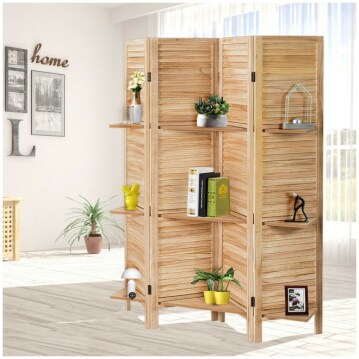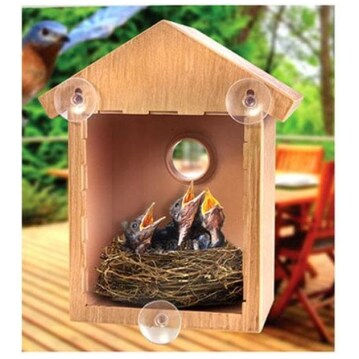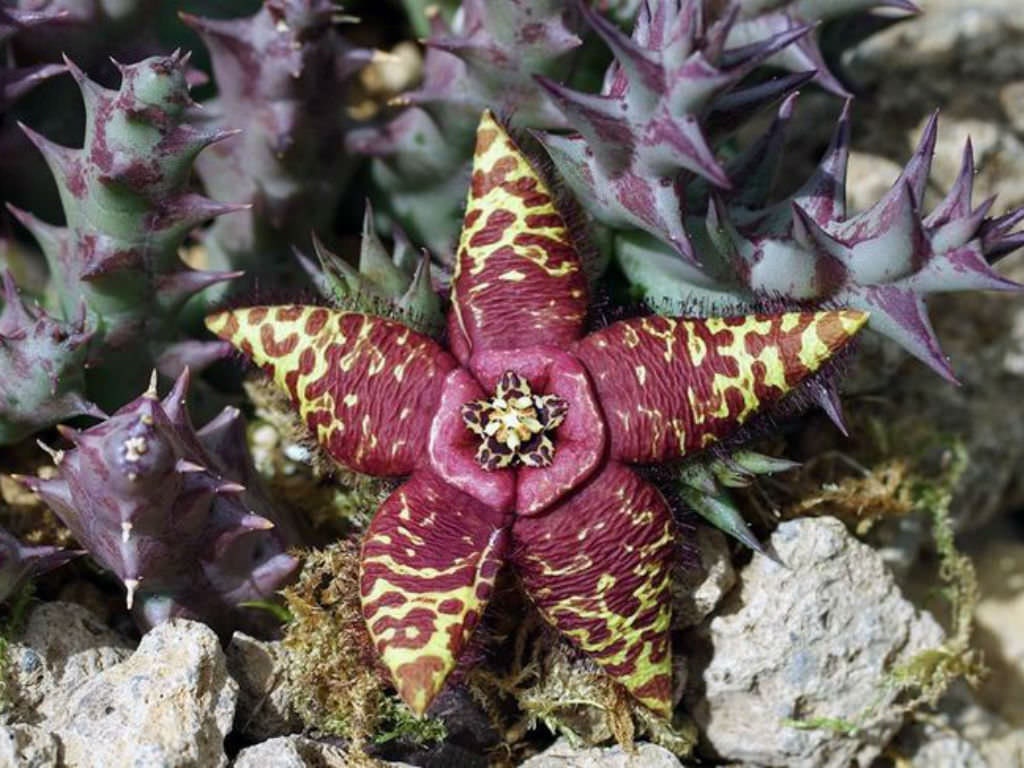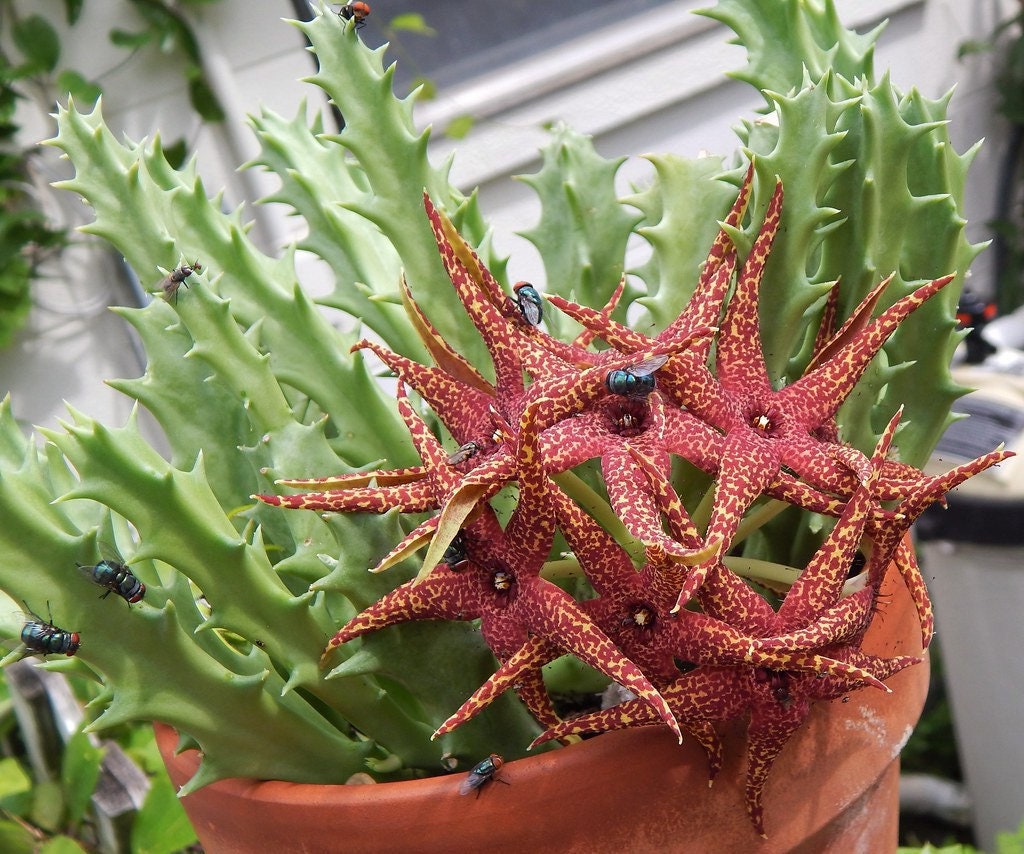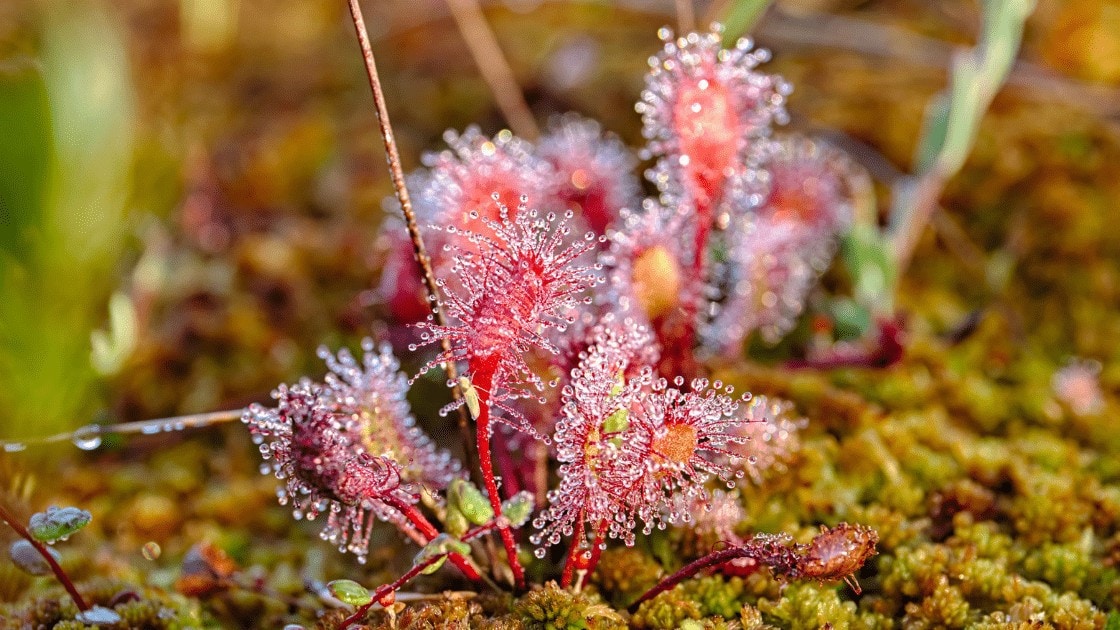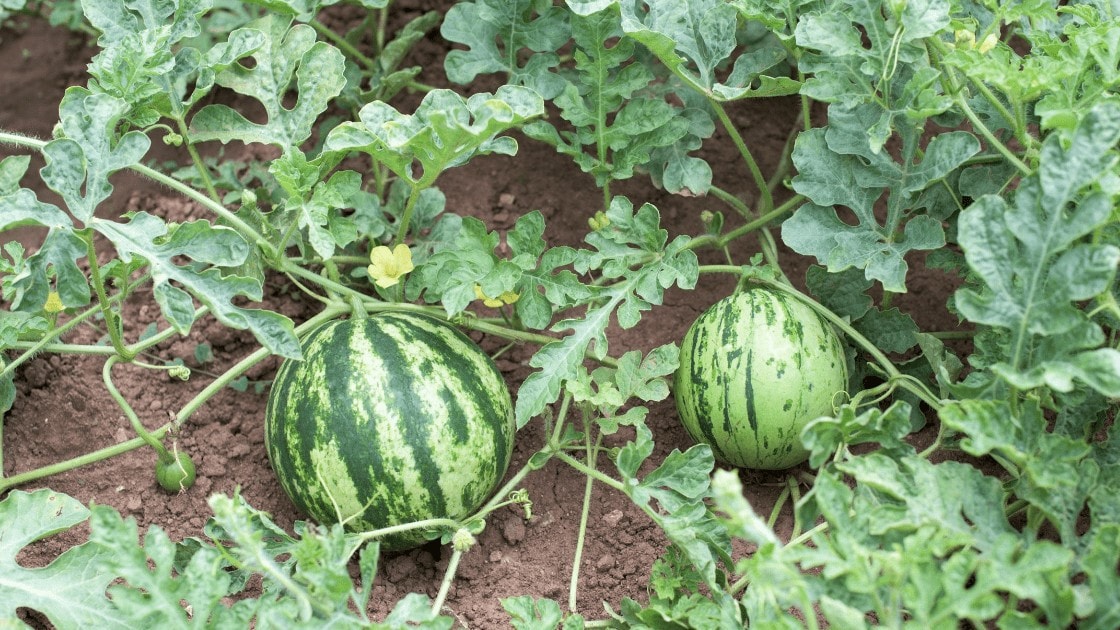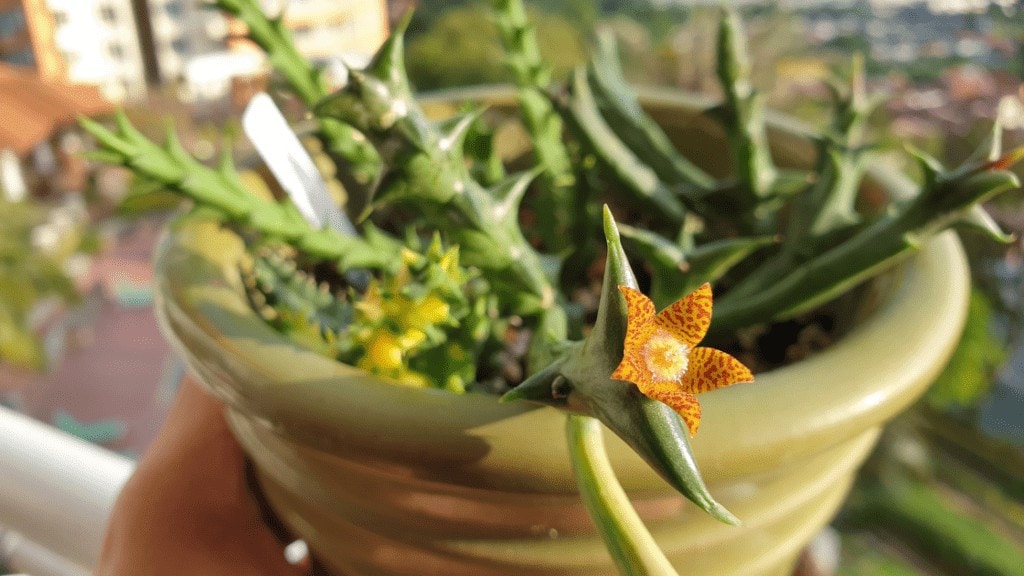
Orbea Schweinfurthii is a unique and relatively rare succulent that is visually similar to many of the members of the more popular Stapelia genus. In this article, we’ll take a deeper look at the optimum growing conditions of this succulent and will help you deal with a few common problems you may experience.
Orbea Schweinfurthii – Description, Origin and Other Orbea Species
Orbea is a small genus of succulents, which contains about 30 species. The visual differences between some Orbea and Stapelia species can be very small and certain species look so similar that they can only be differentiated by their flowers. The leaves of Orbea Variegata for example looks just like those of most Stapelias. In fact, this species was only recently moved to the Orbea genus and was previously known as Stapelia Variegata.
Orbea Schweinfurthii is a unique member of the Orbea genus in that it gets pollinated by fruit flies and not by Blowflies. Therefore, unlike other Orbeas and Stapelias, its flowers don’t smell that bad – their aroma is similar to that of slightly rotten fruit or red wine. However, before the plant flowers, it can be difficult to identify – Orbea woodii has very similar, spiky leaves, but its flowers have a strong, unpleasant smell of rotting meat, designed to attract Blowflies.
Browse our Affiliate Products
Where Does Orbea Schweinfurthii Commonly Grow In The Wild?
Just like all other Orbea species, Schweinfurthii is native to Africa, where it grows only in very specific terrains. It’s usually found under sparse shrubs, which it uses for physical support as well as for protection from large animals.
Other Orbea Species
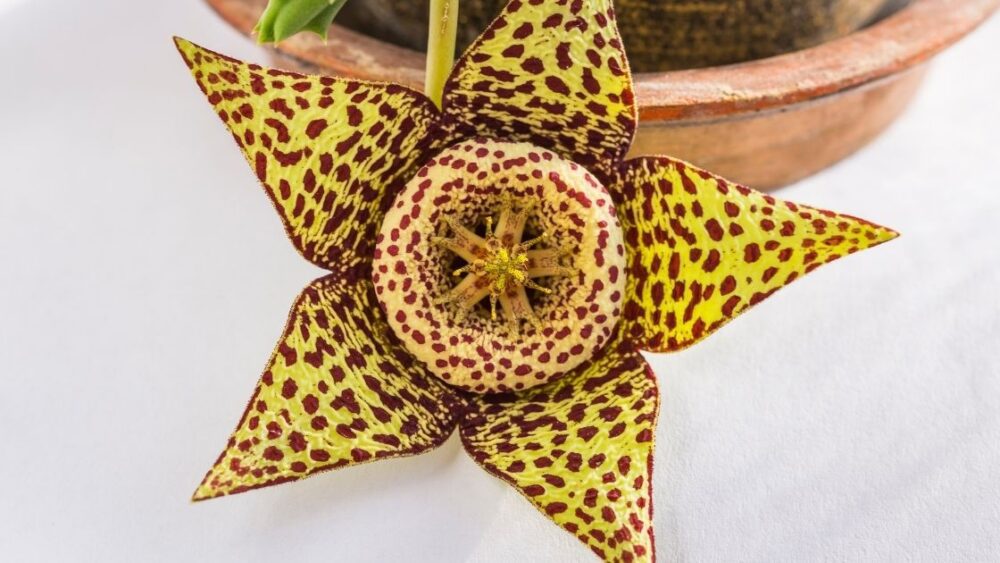
Other Orbea species have flowers that give off unpleasant odor of rotting meat or fish in order to attract Blowflies. Orbea Schweinfurthii is the only widely available Orbea species that instead uses fruity odors to attract fruit flies. Orbea Variegata is probably the most widely available Orbea species and it’s extremely similar to Stapelia.
In the YouTube video below, it showcases other Orbea species, check it out.
Care, Growth Requirements And Propagation
Orbea Schweinfurthii is not difficult to take care of, but can be easily killed by overwatering or by planting in unsuitable soil. Otherwise, it has similar requirements to most other low-growing succulents and is easily propagated by stem cuttings. Now let’s explore the specific optimal growing conditions of this succulent in more detail.
How Fast Does Orbea Schweinfurthii Grow And How Big Does It Get?
Orbea Schweinfurthii has stems that grow slightly longer compared to other Orbeas or Stapelias. In its natural environment in the African wild, the plant usually depends on sparse shrubs, which provide physical support for the long, thin stems. Without this support, the stems usually start falling to the side and resting on the edge of the potting container.
The growth rate of this succulent is difficult to specify, because it’s horizontally-spreading (also known as mat-forming), but each stem usually grows by 2-3 inches per year. The growth rate is very dependent on the light intensity and fertilization.
Does It Grow Better Indoors or Outdoors?
Orbea Schweinfurthii grows very well outdoors, but should not be exposed to sub-freezing temperatures. Temperatures lower than 40F (5C) should be avoided, and that’s around the minimum temperature that this plant experiences in its natural habitat during the winter. You should move the plant indoors during the winter, unless you live in a USDA zone above 10.
Winter Dormancy Requirements
In its natural habitat in South Africa, the plant goes through winter dormancy from May till September, when the temperatures drop to around 50F (10C). During this time, it barely requires any water. Just like all other succulent, the plant uses CAM photosynthesis and opens up its stomata (the tiny pores on the leaves) only at night.
During the dormancy period, this opening of the stomata is greatly reduced and as a result, the plant doesn’t photosynthesize much and barely loses any water through its leaves. Watering the plant during this rest period is a mistake that can sometimes lead to deadly root rot.
Providing the 40-50F temperature range necessary for dormancy can be difficult – a garage heated by a low-power electric heater is one option.
How Much Sun Is Required?
The plant likes bright sunlight. Without enough light, it will barely grow and it won’t develop the characteristic line patterning on its leaves. Its flowering will also be suppressed, due to insufficient energy reserves. It’s recommended that you bring Orbea outdoors during the summer and place it in a bright spot in full sunlight for most of the summer.
What Type Of Soil Is Required?
Although Orbea can do well in general purpose cactus potting mixes, a more sandy medium, rich in inert silicate rocks (like river sand) usually works better.
It’s worth experimenting with mixes containing high percentages (up to 50%) of river sand and small rocks, the rest being potting soil or compost. Orbea tolerates excessive drought much better than excess moisture, so water-holding ingredients like perlite are not recommended. As already mentioned, cactus potting mixes can also work well, but it’s important to get the watering frequency right and provide a long dry period between each watering.
Is Feeding/Fertilization Necessary?
For fast growth, fertilization is necessary and a soluble cactus fertilizer should be applied regularly during the growth period of the succulent – from early spring till late autumn.
Make sure to alternate fertilizer with plain water to avoid salt buildup and use only dilute solutions of around 1/2 to 1/4th the recommended strength. Fertilizing during the dormancy period is a recipe for disaster and can easily damage the roots of the plant.
Watering Frequency
Letting the top of the soil dry up and then waiting an additional 5-10 days before each watering usually works best. This usually means a watering frequency of around twice per a month for most types of pots.
During the autumn, the watering frequency should be reduced to once a month and during the dormancy period in December through February the succulent shouldn’t be watered at all. If you notice dehydration and stem wrinkling during the dormancy period, this usually means that the plant isn’t really in dormancy, usually because the temperature hasn’t dropped low enough or the day length has been unnaturally prolonged by indoor lighting.
Is Repotting Ever Necessary And When Should You Do It?
Anecdotally, Orbeas and Stapelias seem to prefer undersized pots, which promotes flowering. The plant can be tricky to repot because of its wide root structure. Instead of caring for a single Orbea plant and regularly repotting it, it’s best to regularly take cuttings and start new plants in fresh soil – this is easier, more satisfying and there is no risk of damaging the roots.
For more information about different types of pots, check out this article. What is the perfect pot for my plants?
Is Orbea Easy To Propagate And How To Do It?
Orbea Schweinfurthii is easily propagated via stem cuttings. Even without using rooting hormone, the cuttings develop roots surprisingly quickly – usually in less than 2 weeks.
Before sticking the stem cuttings in some sand, make sure to let them dry out a bit in order for the cut to form a thin protective layer of dead tissue. This will protect the cutting from bacterial rot. Orbea cuttings can be rooted in all sorts of media, including pure perlite or pure sand. Usually, those types of inert, mineral-based media provide a much lower risk for rotting or fungal infections. Soil on the other hand contains a lot of bacteria and can lead to problems.
When Does Orbea Schweinfurthii Flower?
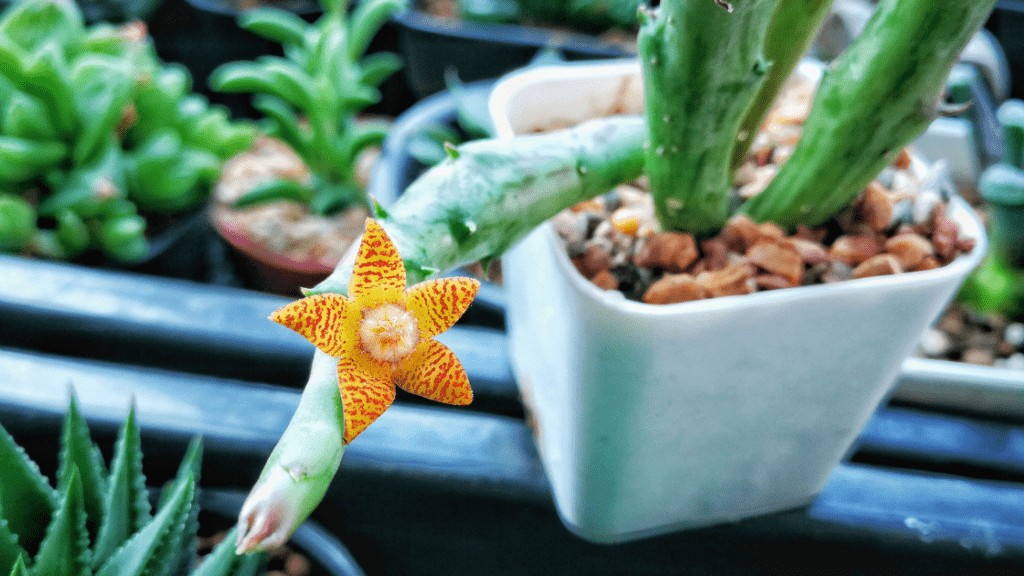
In most locations, the succulent usually blooms once spring is over the daylight duration increases.
Orbea Schweinfurthii produces much smaller flowers compared to other similar species, but there’s also a larger number of them. The flowers usually last 3-4 days, but if the plant is moved to a shaded spot, they can last for up to a week.
Flowering requires good growing conditions and if your plant doesn’t appear to flower, this is usually caused by insufficient sunlight or by not providing the plant with its necessary dormancy period.
Should You Do Anything When Blooming Starts?
Apart from enjoying the interesting flowers and taking pictures of them, you may want to pollinate them and collect seeds from the fruits that form.
The plant will usually get pollinated by fruit flies on its own, as the rotten fruit smell readily attracts them from a long distance away. The seeds of all plants in the Orbea genus germinate quickly, in less than 2 weeks and the seedlings grow surprisingly quickly, especially when lightly fertilized.
Common Problems You May Experience
Overwatering and an unsuitable, compacted soil are the two most common sources of potential problems. Both of those factors can lead to root rot which can kill the succulent. Apart from that, stressed plants make great hosts for mealybugs and fungal infestations, especially if the ambient humidity is too high.
Wilting, Wrinkling and Stem/Leaf Dehydration
Paradoxically, those symptoms are usually caused by over-watering and oxygen deprivation of the roots.
If the problem develops slowly and worsens steadily, this usually signals root rot. The best way to solve the problem is to uproot the plant, get rid of any black rotten roots, let it dry out a bit and replant it in fresh soil. If a very large percentage of the roots have become black and rotten, the only solution may be to sacrifice the plant and cut it up into cuttings to be rooted.
Lack of Color
This is caused by lack of sunlight. Most of the pigments contained in the leaves act as natural sunscreen, so in the absence of strong sunlight, there is no reason for the plant to manufacture them.
Paleness and yellowing despite abundant sunlight may be a result of overwatering, fertilizer burn or insufficient nutrition in the soil. Yellowing tips of the leaves can be the first symptom of root rot, and are a signal that you should start watering the plant less-frequently.
The Succulent Isn’t Blooming
Orbea Schweinfurthii blooms a month or two after its dormancy period is over. Without a dormancy period, the plant may not bloom at all. Insufficient light will also prevent flowering – windowsills usually don’t provide enough direct sunlight for most succulents, including Orbea.
Pests and Diseases
Fungal diseases and insect infestations usually occur only in stressed plants in poor health. In most cases, overwatering can be traced back as the root cause, leading first to black root rot and then to weakening of the stems, allowing fungus to grow and insects to penetrate the outer coat of the leaves.
Although anti-fungal sprays and insecticides can temporarily solve the problem, it’s best to investigate the root health of the plant and make sure it receives enough sunlight and nutrients to be able to build up its defenses.
Final Thoughts
Orbea Schweinfurthii is a very interesting and a somewhat rare succulent in the Stapelia family. It’s relatively easy to take care of and is very easily propagated via stem cuttings. Because of that, even if you accidentally kill the plant, a few remaining stems are enough to give life to a new one. Sandy soil, plenty of sunlight and infrequent watering, combined with the occasional fertilization are the most important factors in successfully caring for this succulent.

